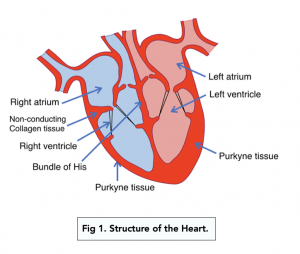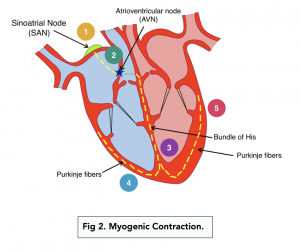Controlling Heart Rate (A-level Biology)
Myogenic Contraction
The heart is made up of cardiac muscle, a specialised tissue known as myogenic tissue. It is able to initiate its own contraction within the muscle cells, meaning it isn’t dependent on external signals from the nervous system.

The right atrium wall is where specialised fibres called the sinoatrial node (SAN) is located. It is also known as the ‘pacemaker of the heart’ as it is what starts the wave of electrical stimulation. The process is described below:
- The sinoatrial node produces a wave of electrical stimulation. The SAN sends a wave of electricity to the atrial walls which causes the atria to contract at approximately the same time.
- The signal passes down the atrial septum. A thin layer of collagen tissue at the base of the atria prevents the wave of electricity from reaching the ventricles. Instead, the SAN passes the electricity to the atrioventricular node (AVN), located between both the atria.
- The atrioventricular node (AVN) conducts the signal to the ventricles. The AVN passes the wave of electricity down the nerves of the bundle of His. There is a slight delay in this, so the muscle of the ventricles don’t contract before the atria can fully empty.
- The bundle of His transmits the wave to the base of the heart. The bundle is comprised of muscle fibres that extend from the AVN to the apex (bottom) of the heart, where it splits into the Purkinje fibres and branches up into each ventricle.
- The electricity passes up the Purkinje fibres. This allows the ventricles to contract from the base up, which allows the ventricles to fully empty, pushing the blood into the aorta and pulmonary artery.

Control of Heart Rate
The Sinoatrial Node (SAN)
The sinoatrial node (SAN) connects to two nerves which are located in the medulla oblongata, in the brain:
- The accelerator nerve is part of the sympathetic nervous system and delivers a higher than usual frequency of impulses to the SAN to increase the heart rate.
- The vagus nerve is opposite to the accelerator nerve as it is part of the parasympathetic nerve and works to decrease the heart rate by delivering a lower than usual frequency of impulses to the SAN.
Receptors of the Heart
Resting heart rate is determined by the internal pacemaker (SAN). But, it can be regulated by the brain. The heart rate can increase or decrease in response to internal stimuli.
There are two types of receptors to detect changes. Both are located in the aorta and carotid arteries:
-
- Chemoreceptors detect chemical changes, such as oxygen concentration, carbon dioxide levels and the pH of the blood. They are also found in the medulla.
-
- Baroreceptors detect changes in blood pressure. They are found in the carotid arteries (in the neck) and aorta.
Medulla Oblongata
The medulla oblongata is a section of the brain that controls autonomic functions, such as digestion, heart rate and breathing.
It controls the heart rate by altering the speed at which the SAN fires.
Role of the Autonomic Nervous System
The medulla is connected to the SAN by two types of neurone, parasympathetic and sympathetic.
-
- The parasympathetic neurones secrete acetylcholine – a type of neurotransmitter. This decreases heart rate.
-
- The sympathetic neurones secrete noradrenaline – another type of neurotransmitter. This increases heart rate.
Baroreceptors
High blood pressure
- If high blood pressure is detected, impulses are sent from the baroreceptors to the medulla – this will send the impulse down parasympathetic neurones.
- This causes acetylcholine to be released in the cardiac muscle, binding to receptors on the SAN.
- The heart rate will slow to decrease the blood pressure.
Low blood pressure
- Inversely, if low blood pressure is detected, impulses are sent down sympathetic neurones by the medulla.
- This causes noradrenaline to be realised in the cardiac muscle, binding to receptors on the SAN.
- The heart rate will speed up to increase the blood pressure.
Chemoreceptors
High blood oxygen, pH or low carbon dioxide
- If these changes are detected, impulses are sent from the chemoreceptors to the medulla – this will send the impulse down parasympathetic neurones.
- This causes acetylcholine to be released in the cardiac muscle, binding to receptors on the SAN.
- The heart rate will slow to return the oxygen, carbon dioxide and pH of the blood to normal levels.
Low blood oxygen, pH or high carbon dioxide
- If these changes are detected, impulses are sent down sympathetic neurones by the medulla.
- This causes noradrenaline to be released in the cardiac muscle, binding to receptors on the SAN.
- The heart rate will speed up to return the oxygen, carbon dioxide and pH or the blood to normal levels.
Heart Rate Changes
When the heart rate changes, there are steps taken to try and return it to a normal rhythm. Below are the steps that happens when the heart rate changes:
- The relevant receptors send an impulse to the cardiac control centre, located in the medulla oblongata.
- The impulse then gets sent to the sinoatrial node along the sympathetic neurone where depolarisation occurs. The SAN releases noradrenaline which results in an increased heart rate
Conversely to the process of increasing the heart rate, decreasing the heart rate is the opposite to the steps above.
When the factors that affect the heart rate return to normal, the impulses return to their usual frequency to maintain a steady heart rate.
Heart rate refers to the number of heartbeats per minute. It is an important physiological measure as it can indicate an individual’s level of physical exertion, stress, and overall cardiovascular health.
Heart rate can be influenced by a variety of factors, including exercise, stress, age, medications, and underlying medical conditions.
The autonomic nervous system is responsible for controlling heart rate. The sympathetic nervous system increases heart rate, while the parasympathetic nervous system slows it down.
The sinoatrial (SA) node is responsible for initiating the electrical impulses that control the contraction of the heart. It acts as the natural pacemaker for the heart and determines the heart rate.
The atrioventricular (AV) node acts as a relay between the atria and ventricles, transmitting electrical impulses from the atria to the ventricles. It regulates the heart rate by slowing down the impulses to allow the ventricles to fill properly before contracting.
Exercise increases heart rate as it stimulates the sympathetic nervous system, causing the heart to beat faster. This increases the amount of blood being pumped and delivers oxygen and nutrients to the muscles.
Stress increases heart rate as it activates the sympathetic nervous system, causing the heart to beat faster. This prepares the body for the “fight or flight” response to perceived danger.
Some medications, such as beta blockers and calcium channel blockers, can slow heart rate by blocking the effects of the sympathetic nervous system. Other medications, such as stimulants, can increase heart rate by activating the sympathetic nervous system.
An irregular heart rate can be a sign of an underlying health problem, such as arrhythmia or heart disease. An irregular heart rate can also lead to decreased cardiac output, decreased blood flow to the brain and other vital organs, and increased risk of heart attack or stroke.






Still got a question? Leave a comment
Leave a comment